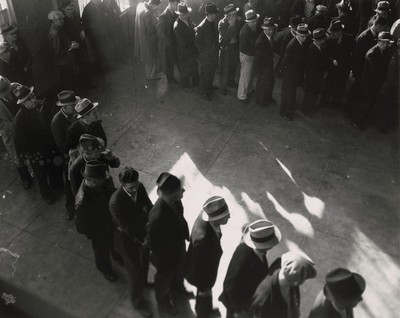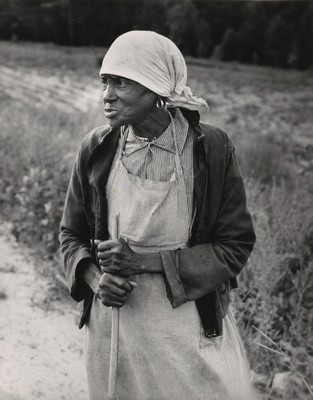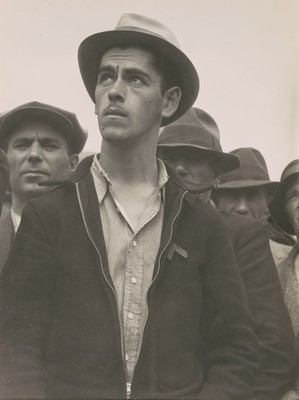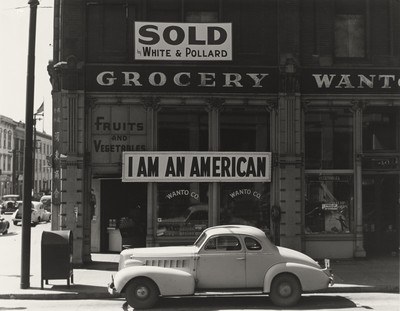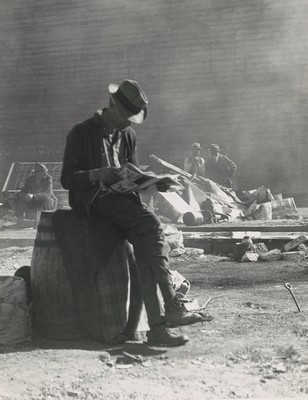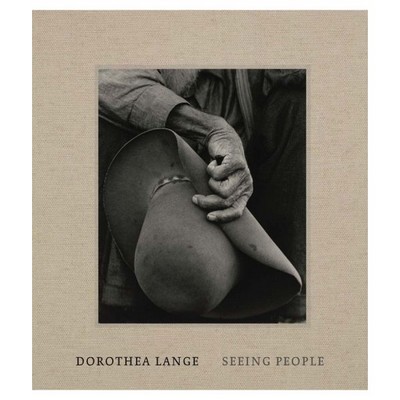Dorothea Lange: Seeing People
National Gallery of Art, Washington DC
November 5, 2023 – March 31, 2024
Child Living in Oklahoma City Shacktown, August 1936
gelatin silver print
image: 24.2 x 19.4 cm (9 1/2 x 7 5/8 in.)
mat: 17 x 14 in.
The Museum of Modern Art, New York. Purchase
End of Shift, 3:30, Shipyard Construction Workers, Richmond, California, September 1943
gelatin silver print
image: 24 x 19 cm (9 7/16 x 7 1/2 in.)
sheet: 25.4 x 20.32 cm (10 x 8 in.)
mat: 18 x 14 in.
frame (outside): 19 x 15 in.
National Gallery of Art, Washington, Gift of Daniel Greenberg and Susan Steinhauser
© The Dorothea Lange Collection, Oakland Museum of California, City of Oakland. Gift of Paul S. Taylor
Line of men inside a division office of the State Employment Service office at San Francisco, California, waiting to register for unemployment benefits, January 1938, printed c. 1960s
gelatin silver print
image: 19 x 24 cm (7 1/2 x 9 7/16 in.)
sheet: 25.08 x 20.32 cm (9 7/8 x 8 in.)
mat: 14 x 17 in.
frame (outside): 15 x 18 in.
National Gallery of Art, Washington, Gift of Daniel Greenberg and Susan Steinhauser
Formerly Enslaved Woman, Alabama, from The American Country Woman, 1938, printed c. 1955
gelatin silver print
image: 24 x 19 cm (9 7/16 x 7 1/2 in.)
sheet: 25 x 20 cm (9 13/16 x 7 7/8 in.)
mat: 16 x 13 in.
frame (outside): 17 x 14 in.
National Gallery of Art, Washington, Gift of Daniel Greenberg and Susan Steinhauser
During her prolific and groundbreaking career, the American photographer Dorothea Lange (1895–1965) made some of the most iconic portraits of the 20th century. Dorothea Lange: Seeing People examines Dorothea Lange’s decades-long investigation into how portrait photography could embody the humanity of the people she depicted. It demonstrates how her photographs helped shape contemporary documentary practice by connecting everyday people with moments of history—from the Great Depression through the mid-1960s—that still resonate with our lives in the 21st century. Featuring 101 photographs, the exhibition addresses her innovative approaches to picturing people, emphasizing her work on various social issues including economic disparity, migration, poverty, and racism. The exhibition is on view in the West Building of the National Gallery of Art.
“Throughout the course of her 50-year career, Lange created an intensely humanistic body of work that sought to transform how we see and understand people,” said Kaywin Feldman, director of the National Gallery of Art. “Merging her skills as a portrait artist, a social documentary photographer, and a storyteller, she helped redefine photography through images that emphasize social issues.”
Dorothea Lange: Seeing People examines how Lange’s portraits have shaped our contemporary understanding of documentary photography as well as its importance to her vision and creative practice. Divided into six thematic sections, the exhibition features portraits ranging from her early career as a San Francisco studio photographer—the earliest work is from 1919—and her powerful coverage of the Great Depression through expressive photographs of everyday people and communities during the 1950s and early 1960s.
Among the works on view are portraits of Indigenous people in Arizona and New Mexico from the 1920s and early 1930s; later depictions of striking laborers, migrant farmworkers, rural African Americans during the Jim Crow era, Japanese Americans denied their civil rights during World War II, and postwar baby boomers; and portraits of people in Ireland, Korea, Vietnam, Egypt, and Venezuela that Lange made in the decade before her death in 1965.
Lange began her career as a commercial studio photographer in San Francisco in 1918. Her studio became a gathering spot for artists who had serious discussions about photography and art. In 1920 she married Maynard Dixon, a painter of western subjects, who encouraged Lange to take her photography outside. She accompanied him on trips through the American Southwest, photographing rural landscapes and Dixon at work, along with the Indigenous communities he was portraying.
She started to work in the streets of San Francisco in 1933, making photographs such as White Angel Breadline, San Francisco, California (1933) that capture the effects of the Great Depression and the plight of the city’s dispossessed men and women. Lange also photographed labor organizers and protesters at May Day events around San Francisco’s Civic Center Plaza: she focused on the protesters speaking, listening, or holding signs, and vowed to produce prints within 24 hours, as in May Day, San Francisco, California (1934). She also documented ensuing strikes, creating portraits of speakers and demonstrators with placards as well as photographs of the police presence in works such as Street Demonstration, San Francisco (1934). When she met the labor economist Paul Schuster Taylor in 1934, Lange began to photograph the plight of migrant farmers who had moved to California from the South and Midwest seeking new livelihoods.
Dispossessed Arkansas farmers. These people are resettling themselves on the dump outside of
Bakersfield, California, from An American Exodus, 1935
gelatin silver print
image: 24.1 x 18.8 cm (9 1/2 x 7 3/8 in.)
sheet: 25.3 x 20.7 cm (9 15/16 x 8 1/8 in.)
mat: 16 x 14 in.
frame (outside): 17 x 15 in.
National Gallery of Art, Washington, Gift of Daniel Greenberg and Susan Steinhauser
Street Meeting, San Francisco, 1934
gelatin silver print
image/sheet: 23.5 x 17.5 cm (9 1/4 x 6 7/8 in.)
mat: 16 x 13 in.
frame (outside): 17 x 14 in.
National Gallery of Art, Washington, Gift of Daniel Greenberg and Susan Steinhauser
© The Dorothea Lange Collection, Oakland Museum of California, City of Oakland. Gift of Paul S. Taylor
Japanese American-Owned Grocery Store, Oakland, California, March 1942
gelatin silver print
image: 19 x 24.4 cm (7 1/2 x 9 5/8 in.)
sheet: 20.3 x 25.4 cm (8 x 10 in.)
mat: 14 x 18 in.
frame (outside): 15 x 19 in.
National Gallery of Art, Washington, Gift of Daniel Greenberg and Susan Steinhauser
Unemployed Man, San Francisco, California, 1934, printed before 1950
gelatin silver print
image: 24.8 x 19.1 cm (9 3/4 x 7 1/2 in.)
sheet: 25.2 x 19.6 cm (9 15/16 x 7 11/16 in.)
mat: 16 x 14 in.
frame (outside): 17 x 15 in.
National Gallery of Art, Washington, Gift of Daniel Greenberg and Susan Steinhauser
© The Dorothea Lange Collection, Oakland Museum of California, City of Oakland. Gift of Paul S. Taylor
Demonstration, San Francisco, 1934
gelatin silver print
image: 12.1 x 14.3 cm (4 3/4 x 5 5/8 in.)
sheet: 12.1 x 14.3 cm (4 3/4 x 5 5/8 in.)
mount: 14.6 x 23.8 cm (5 3/4 x 9 3/8 in.)
Lent by The Metropolitan Museum of Art, Gilman Collection, Purchase, Joseph M. Cohen Gift, 2005
(2005.100.309)
From 1935 to 1943, while working for the for the US Resettlement Administration, Farm Security Administration, and War Relocation Authority, Lange focused on the resilience of Depression-era families, farmworkers, rural cooperative communities, migrant camps, and the forced incarceration of Japanese Americans in the early days of World War II. The resulting images illustrate the human and economic impact wrought across the United States by farm tenancy, racism, the legacy of slavery, climate change, and migrations. These portraits, sometimes combined with interviews, added a personal element to Lange’s stark pictures of makeshift housing and agricultural fields and cemented her documentary style.
During World War II Lange produced one of her most powerful series for the War Relocation Authority, depicting the forced incarceration of California’s Japanese Americans at Manzanar, in works on view such as Grandfather and Grandson of Japanese Ancestry at a War Relocation Authority Center, Manzanar, California (July 1942). She also photographed the shifts in California’s social fabric as its rising economy—sparked by growing defense industries—drew African Americans from the South and women into previously male-dominated and segregated businesses such as shipbuilding. In the 1950s, Lange continued to pursue stories about people and their communities for personal projects, as well as for Life magazine, that include her first photographs from Europe. Asia, South America, and North Africa.
Exhibition Publication
Published by the National Gallery of Art and distributed by Yale University Press, this 208-page illustrated volume explores Dorothea Lange’s decades-long investigation of how photography, through articulating people’s core values and their sense of self, helped to expand our current understanding of portraiture and the meaning of documentary practice. Lange’s sensitive, humane portraits of often-marginalized people galvanized public understanding of important social problems in the 20th century.Compassion guided Lange’s early portraits of Indigenous people in Arizona and New Mexico from the 1920s and 1930s, as well as her depictions of striking workers, migrant farmers, rural African Americans during the Jim Crow era, Japanese Americans in internment camps, and the people she met while traveling in Europe, Asia, Venezuela, and Egypt. Drawing on new research, Philip Brookman, Sarah Greenough, Andrea Nelson, and Laura Wexler, examine Lange’s roots in studio portraiture and demonstrate how her influential and widely seen photographs addressed issues of identity as well as social, economic, and racial inequalities—topics that remain as relevant for our times as they were for hers.
The exhibition is organized by the National Gallery of Art, Washington.
This exhibition is curated by Philip Brookman, consulting curator in the department of photographs, National Gallery of Art.
NATIONAL GALLERY OF ART
6th Street and Constitution Avenue NW, Washington, DC 20565



